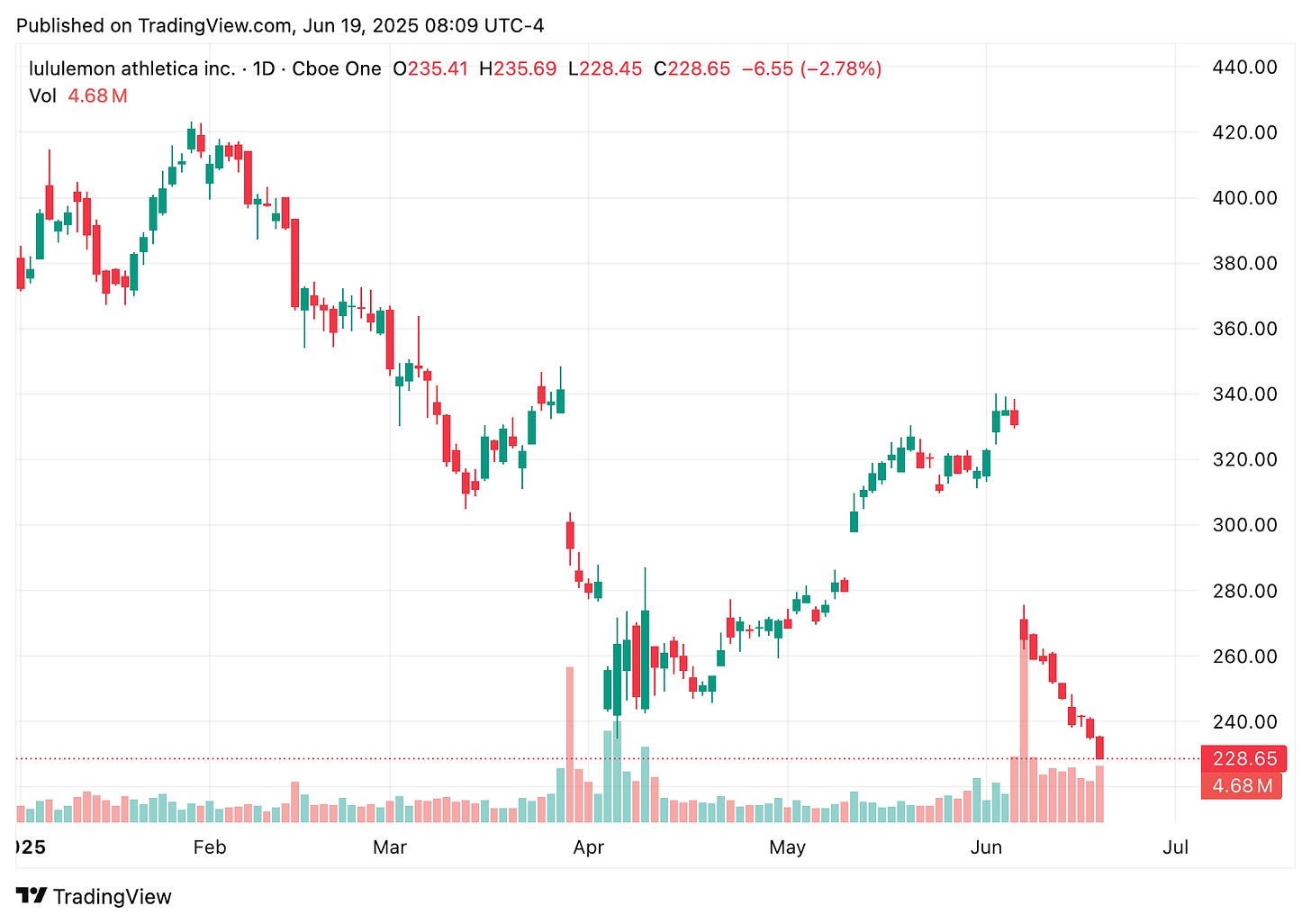Lululemon’s Wake-Up Call: Why a 22% Plunge Might Be the Best Thing for Long-Term Investors
The stock just got body-slammed—but beneath the headlines is a rare setup for bold investors who know how to read the blood in the water.
What Just Happened?
On the surface, it looked like a rug pull.
Lululemon released Q1 2025 results… and investors sprinted for the exits. The stock plummeted over 22% after hours, triggered by soft same-store sales in North America and weaker-than-expected guidance for the full year.
But if you're only watching the surface, you're missing the deeper signal. Because this wasn't just about one bad quarter—it was the moment a market darling hit its first real wall. And in moments like these, wealth changes hands.
YTD Performance: The Emotional Rollercoaster
Lululemon (NASDAQ: LULU) is down approximately 40% year to date as of June 18, 2025. That’s a staggering fall from grace for a company once considered untouchable in premium retail.
Let’s put that into context:
LULU: -40% YTD
Nike (NKE): -20% YTD
S&P 500 (SPY): +2.3% YTD
From a late-2023 peak around $480 to its current level near $228, LULU’s market cap has been nearly chopped in half. This isn’t just a cool-off—it’s a full-blown re-pricing.
And in that lies the setup.
The Bear Case: Why the Crowd Ran
1. Domestic weakness is real.
North American comparable sales declined 3%. That’s not just a hiccup—that’s a slowdown in the region that built Lululemon’s brand. Investors interpreted it as a crack in the foundation.
2. Guidance sliced, optimism dulled.
The company cut its full-year outlook, which spooked the Street. Suddenly, growth estimates felt inflated. And when future growth gets re-rated down, valuations follow.
3. Market rotation punished momentum stocks.
LULU wasn't alone. High-multiple growth stocks across retail took hits as investors shifted back to cash flow-rich, value-centric names. Lululemon’s lofty valuation was no longer safe—it became a target.
But Here’s the Thing…
When you strip away the panic, what’s left is a business still posting 34% same-store sales growth in China. A brand with 59% gross margins. And a product lineup people are still obsessed with.
The long-term question isn’t “why did the stock fall?” It’s “what does this business look like in five years?”
What the Smart Money Is Watching
1. The brand moat hasn’t eroded.
Lululemon is still dominant in a category it defined. It has fierce loyalty. People don’t just wear Lululemon—they evangelize it.
2. Global runway is long.
U.S. demand may be softening, but international growth is just getting warmed up. The China surge wasn’t a fluke—it was validation of a global brand strategy hitting its stride.
3. Operational excellence remains.
Even with the stumble, Lululemon remains lean. Inventory turnover is strong. Debt levels are conservative. And leadership has proven they can course-correct without panic.
The Setup: This Is How Upside Is Created
Every great investment has its turning point—the moment it goes from media punching bag to breakout comeback story. The mistake most investors make? They wait too long. They want confirmation. But by the time it comes, the easy money’s gone.
What if this 22% drop is the reset Lululemon needed? What if the company comes back with stronger inventory control, better North American alignment, and an even more aggressive push into global markets?
That’s not just damage control. That’s strategic realignment.
The Playbook
Here’s how this sets up for opportunity:
Watch earnings revisions. Analysts will likely downgrade in the short term. When expectations are low, it's easier to outperform.
Track inventory and margin trends. If LULU can hold its gross margin in the next two quarters, it’s a signal that pricing power remains intact.
Monitor international momentum. China strength was real—watch for expansion into India and Southeast Asia next.
Bottom Line
This isn’t about whether Lululemon is still a good company. It is.
It’s about whether this is the moment the market misprices a great business because it doesn’t know how to value transitions. If you’re long-term focused and willing to embrace a little blood in the water, this is a moment to pay attention—not walk away.
Final Thoughts: The Knockdown That Builds the Next Run
40% down YTD. A single-day 22% plunge. Analysts fleeing the name. These are the moments that test conviction.
But great brands don’t disappear—they adapt. If Lululemon pivots correctly, this could be one of those rare moments where the market hands you an opportunity, wrapped in fear and disguised as failure.
Your move.
Disclaimer: This post is for educational purposes only and should not be taken as financial advice. Always do your own research or consult a qualified financial professional before making investment decisions.


